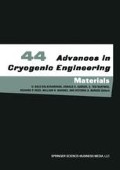Abstract
Tensile properties at 295, 195, 76, and 4 K were measured for eight face-centeredcubic Fe-Ni alloys, ranging from 36-wt% Ni to pure Ni. The elastic limit, yield and tensile strengths, and elongation to failure are reported. Results indicate that the elastic limit and tensile yield and ultimate strengths increase as the Fe content increases. However, the tensile elongation to failure does not appear to depend on Fe content.
Deformation twins were detected in alloys ranging from Fe-36 wt% Ni to Fe-78 wt% Ni. The stress and strain to initiate detectable deformation twins by means of optical microscopy were measured for these alloys. Results show that the initiation of deformation twinning correlates best with deformation energy (stress × strain). These results are discussed in terms of the stacking-fault energy.
Access this chapter
Tax calculation will be finalised at checkout
Purchases are for personal use only
Preview
Unable to display preview. Download preview PDF.
References
R.P. Reed, Acta Met. 15: 1287 (1967).
H. Dietrich, Nickel-Ber. 25 (3): 36–45 (1967).
D.T. Eash, “Tensile Tests on Invar Sheet at Cryogenic Temperatures,” LA-3192-MS, Los Alamos Scientific Laboratory, Los Alamos, New Mexico (4 November 1964 ).
F. Lihl and J. Thöny, Arch. Eisenhüttenw. 34: 701–712 (1963).
International Nickel Company, “Some Properties of INCO Nickel Alloys at Low Temperature,” Development and Research Div., International Nickel Company, 76 Wall Street, New York, New York (1965).
International Nickel Company, unpublished data (1956).
E.T. Wessel, scientific paper 8–0103-P1, Westinghouse Research Laboratories, East Pittsburgh, Pennsylvania (15 February 1956), in: The Mechanical Properties of Nickel and Some Nickel Alloys at Low Temperature,“ R.H. Kropschot and W.F. Graham, eds., NBS Report 5024, National Bureau of Standards, Boulder, Colorado ( 25 October 1956 ).
G.W. Geil and N.L. Carwile, in: “Mechanical Properties of Metals at Low Temperatures,” National Bureau of Standards Circular 520, U.S. Government Printing Office, Washington, D.C. (May 1952), pp. 67–96.
S.J. Rosenberg, “Nickel and Its Alloys,” National Bureau of Standards Monograph 106, U.S. Government Printing Office, Washington, D.C. (May 1968).
S.M. Ram, Acta Metall. 33: 1285–1291 (1985).
I. Retat, Phys. Status Solidi (a) 99: 121–130 (1987).
K. Shibata, M. Kurita, K. Fujita, and T. Fujita, Martensitic transformation and serration of Fe-Ni binary alloys at 4.2 K, presented at International Conference on Martensitic Transformation, Nara, Japan (25–30 August, 1986 ).
W.S. Eberly, Mater. Des. Eng. (July 1963).
O. Dahl, Z. Metallkd. 24: 107–111 (1932).
J.G. Thompson, “Nickel and Its Alloys,” National Bureau of Standards Circular 592, U.S. Government Printing Office, Washington, D.C. (5 February 1958 ).
K.A. Warren and R.P. Reed, “Tensile and Impact Properties of Selected Materials from 20 to 300°K,” National Bureau of Standards Monograph 63, U.S. Government Printing Office, Washington, D.C. (28 June 1963 ).
W D Jenkins and T.G. Digges, J. Res. Natl. Bur. Stand. 48 (4): 313–321 (1952).
R.P. Reed, R.L. Tobler, and J.W. Elmer, in: “Proceedings of the International Cryogenic Materials Conference, Kobe, Japan,” Butterworths, London (1983), pp. 98–103.
B.E.P. Beeston, private communication, GEC-AEI Electronics, Ltd., Harlow, Essex, England (2 April 1968 ).
R.L. Tobler, R.P. Reed, and D.S. Burkhalter, in: “Advances in Cryogenic Engineering (Materials),” vol. 26, Plenum, New York (1980), pp. 107–119.
R.P. Reed and J.M. Arvidson, in: “Advances in Cryogenic Engineering (Materials),” vol. 30, Plenum, New York (1984), pp. 263–270.
J. Echigoya, S. Hayashi, and M. Yamamoto, Phys. Stat. Solidi (a) 14: 463–471 (1972).
H. Flor, H.J. Gudladt, and C. Schwink, Acta Metall. 28: 1611–1619 (1980).
Proc. Int. Symp. on The Invar Problem, J. Magn. Magn. Mater. 10: 1–324 (1979).
H.M. Ledbetter and R.P. Reed, J. Phys. Chem. Ref. Data 2 (3): 531–618 (1974).
R.J. Weiss, Proc. Phys. Soc. 82: 281–288 (1963).
R.P. Reed and R.E. Schramm, J. Appl. Phys. 40 (9): 3453–3458 (1969).
G.F. Bolling and R.H. Richman, Philos. Mag. B19: 247–264 (1969).
R.P. Reed, Philos. Mag. 15 (137): 1051–1055 (1967).
R.P. Reed, unpublished data measured at the National Institute of Standards and Technology, Boulder, Colorado (1996).
I. Retat, T. Steffens, and C. Schwink, Phys. Stat. Solidi (a) 92: 507–510.
Author information
Authors and Affiliations
Editor information
Editors and Affiliations
Rights and permissions
Copyright information
© 1998 Springer Science+Business Media New York
About this chapter
Cite this chapter
Reed, R.P. (1998). Low-Temperature Tensile Properties of Fe-Ni Alloys. In: Balachandran, U.B., Gubser, D.G., Hartwig, K.T., Reed, R.P., Warnes, W.H., Bardos, V.A. (eds) Advances in Cryogenic Engineering Materials . Advances in Cryogenic Engineering, vol 44. Springer, Boston, MA. https://doi.org/10.1007/978-1-4757-9056-6_4
Download citation
DOI: https://doi.org/10.1007/978-1-4757-9056-6_4
Publisher Name: Springer, Boston, MA
Print ISBN: 978-1-4757-9058-0
Online ISBN: 978-1-4757-9056-6
eBook Packages: Springer Book Archive

